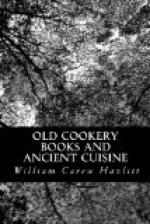38. Apician Morsels; or, Tales of the Table, Kitchen, and Larder. By Dick Humelbergius Secundus. 8vo, London, 1834.
39. Cottage Economy and Cookery. 8vo, London, 1844.[Footnote: Reprinted from the Journal of the Agricultural Society, 1843, vol. iii, part I].
DIET OF THE YEOMAN AND THE POOR.
The staple food among the lower orders in Anglo-Saxon and the immediately succeeding times was doubtless bread, butter, and cheese, the aliment which goes so far even yet to support our rural population, with vegetables and fruit, and occasional allowances of salted bacon and pancakes, beef, or fish. The meat was usually boiled in a kettle suspended on a tripod [Footnote: The tripod is still employed in many parts of the country for a similar purpose] over a wood-fire, such as is used only now, in an improved shape, for fish and soup.
The kettle which is mentioned, as we observe, in the tale of “Tom Thumb,” was the universal vessel for boiling purposes [Footnote: An inverted kettle was the earliest type of the diving-bell], and the bacon-house (or larder), so called from the preponderance of that sort of store over the rest, was the warehouse for the winter stock of provisions [Footnote: What is called in some places the keeping-room also accommodated flitches on the walls, and hams ranged along the beams overhead; and it served at the same time for a best parlour]. The fondness for condiments, especially garlic and pepper, among the higher orders, possibly served to render the coarser nourishment of the poor more savoury and flavorous. “It is interesting to remark,” says Mr. Wright [Footnote: “Domestic Manners and Sentiments,” 1862, p. 91], “that the articles just mentioned (bread, butter, and cheese) have preserved their Anglo-Saxon names to the present time, while all kinds of meat—beef, veal, mutton, pork, even bacon—have retained only the names given to them by the Normans; which seems to imply that flesh-meat was not in general use for food among the lower classes of society.”
In Malory’s compilation on the adventures of King Arthur and his knights, contemporary with the “Book of St. Alban’s,” we are expressly informed in the sixth chapter, how the King made a great feast at Caerleon in Wales; but we are left in ignorance of its character. The chief importance of details in this case would have been the excessive probability that Malory would have described an entertainment consonant with the usage of his own day, although at no period of early history was there ever so large an assemblage of guests at one time as met, according to the fable, to do honour to Arthur.




